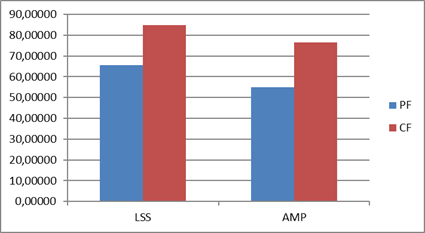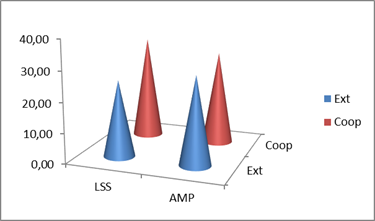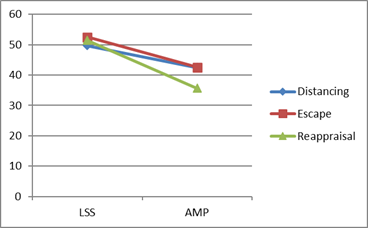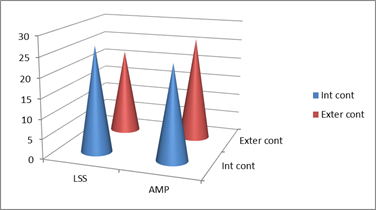Abstract
The objective of the present study was to reveal the basic parameters of quality of life (QoL) in patients with osteosarcoma after limb salvage surgery and after amputation. Study participants were 80 inpatients with osteosarcoma of the National Medical Research Center of Oncology named after N.N. Blokhin. 39 patients underwent amputation and 41 patients had limb salvage surgery. QoL was studied in a month after the treatment. Method. The Quality of Life Questionnaire (Core 30, of the European Organization for Research and Treatment Cancer) developed by the Study Group on Quality of Life, was used in order to study the aspects of patients’ health-related QoL. Patients’ psychological characteristics were studied by means of the Big V, WCQ and PIL Test questionnaires. Results. The results of the study of QoL basic parameters in patients with osteosarcoma revealed no significant differences between patients who underwent amputation and patients after limb salvage surgery. The patients had similar QoL indices in both functional and symptom scales, and similar pain intensity, too, assessed by patients themselves and their attending physician, except physical and cognitive functioning, which were slightly higher in patients who had limb salvage surgery. Conclusion. The absence of differences in QoL in patients with osteosarcoma after amputation and after limb salvage surgery needs further thorough research in order to reveal psychological factors of adjustment to the disease in these patients.
Keywords: Amputation, limb salvage surgery, osteosarcoma, psychological assessment, psycho-oncology, Quality of life
Introduction
The health-related quality of life (QoL) concept pays attention to patients’ emotional experience of disease, particularly to a personal sense of possibility to satisfy actual needs and possibility of full social functioning in spite of disease limitations. QoL in oncological patients nowadays is studied intensively (Andrews et al., 2019). The issue of QoL in patients with bone tumors after limb salvage surgery (LSS) and amputation is especially actual (Ortiz Cruz et al., 2018; Silva et al., 2019).
For patients after amputation, QoL is associated with pain, adaptation to the prosthesis and psychosocial well-being (Vaz et al., 2012). The ability to walk is considered central to their QoL (Davie-Smith et al., 2017), as well as some clinical characteristics such as the level of amputation, time after amputation, etc. (Matos et al., 2020).
At the same time, researchers do not have a common opinion regarding the level of QoL of patients depending on the surgical intervention that was performed on them. So, some findings suggest that the overall QoL of patients after LSS is significantly higher than the QoL of patients who underwent amputation (Mason et al., 2013). Others report better QoL in patients who underwent amputation than in patients who had LSS (Krans-Schreuder et al., 2012; Tekin et al., 2009). There is also evidence of similar levels of QoL, survival rates, local recurrence and complications in these two groups of patients (Aksnes et al., 2008; Mavrogenis et al., 2012; Robert et al., 2010).
Problem Statement
Despite the importance of the issue, the number of studies aimed at conducting a comparative analysis of QoL of oncological patients after LSS and amputation is still limited, and the results of these studies are contradictory. A detailed study of the parameters of patients’ QoL, taking into account their physical and psychological status, would help to clarify the issue of the positive or negative impact of a particular type of surgical intervention on the QoL of cancer patients and the factors influencing it.
Research Questions
The existing discrepancies in the understanding of the abovementioned problem determined the relevance of this study. Among the research questions that were formulated by the authors when planning the study, the following can be noted:
- to study the main parameters of the QoL of patients after amputation and LSS, including their subjective satisfaction with physical, mental and social functioning, and to compare the QoL in these two groups of patients;
- to study patients’ psychological characteristics, including their personality traits, their coping strategies related to adaptation to the stress of the disease and their perception of a general sense of meaning and purpose in life.
Purpose of the Study
To evaluate the factors that determine the QoL in patients with lower extremity bone and soft tissue cancer, an interdisciplinary study is carried out (Shchelkova et al., 2021). One of the goals of the study was to assess the differences in the psychological characteristics of patients undergoing different types of surgical interventions.
Research Methods
The research was carried out by an interdisciplinary team at the National Medical Research Center of Oncology named after N.N. Blokhin (Moscow, Russia).
Participants
The participants of the study were 80 inpatients of the Center; all of them diagnosed with osteosarcoma. 39 patients underwent amputation and 41 patients had limb salvage surgery. The mean age of patients who underwent amputation was 48±2.2 years and the LSS sample mean age was 33±3.8.
There were 25 males (61 %), 16 females (39 %) in the group of patients who had LSS and 29 males (74 %), 10 females (26 %) in the group of those who underwent amputation.
Instruments
Quality of life was studied using the EORTC QLQ-C30 (Quality of Life Questionnaire Core-30) and a specific module BM22 (Bone Metastases 22) developed by the Study Group on Quality of Life of the European Organization for Research and Treatment Cancer (Aaronson et al., 1993; Fayers et al., 2001).
In order to study personality characteristics, ways of coping and life purposes in patients after LSS and amputation the following questionnaires were used:
- Personality inventory “Big Five” by L. Pervin and O.P. John, which aims at revealing five global personality factors bound up with the levels of extraversion, self-consciousness, cooperation, emotional stability and personal resources. A version of a Russian adaptation of the questionnaire was used.
- Questionnaire “The Ways of Coping Questionnaire” (WCQ) by R. Lazarus and S. Folkman, standardized on a native sample. The method aims at revealing coping strategies that a person uses in stressful and difficult situations.
- “Purpose-in-Life Test – PIL” by D. Krambo and L. Maholik. We used a Russian adaptation of the test, which is described as an instrument to assess person’s experience of ontological life significance.
The data were analyzed using a complex of methods of mathematical statistics.
Findings
The study results showed that the two groups of patients had similar indices of QoL basic parameters, and similar pain intensity, too, assessed by patients themselves and their attending physician. At the same time, a number of differences of QoL functional scales and psychological characteristics was revealed in patients with osteosarcoma after LSS and amputation.
As shown in Table 01, patients who had LSS and those who underwent amputation did not significantly differ in their QoL (p>0.1), more specifically, in the parameters of general health, role, emotional and social functioning, as well as symptoms burden. Patients had similar levels of fatigue, pain and insomnia.

As Figure 01 shows, patients after LSS tended to have a slightly better QoL on the scales “Physical functioning” (PF) (p<0.07) and “Cognitive functioning” (CF) (p<0.09), than patients who underwent amputation. These findings should be tested on a larger sample in the future.

The study of patients’ psychological characteristics revealed the following. As it is shown on Figure 02, the group of patients after LSS was characterized by a slightly lower extraversion rate (p<0.07) and higher cooperation rate (p<0.08), measured by means of the Big V questionnaire, than patients after amputation.

The given above Figure 3 shows the differences that were established in terms of coping behaviour of patients after LSS and amputation. Patients with osteosarcoma who had LSS use the coping strategies of distancing (p<0.008), escape–avoidance (p<0.001) and positive reappraisal (p<0.001) significantly more often than patients with osteosarcoma who underwent amputation.

The study of the subjects by means of the PIL Test revealed (Figure 4) that patients who went through LSS were characterized by an internal locus control (p<0.05), whereas the patients who underwent amputation had an external locus control (p<0.001).
Our research, as well as studies conducted earlier (Furtado et al., 2017), shows that surgical treatment for a patient with sarcoma of the lower extremity is a traumatic event, and has a severe impact on patients and their quality of life.
It was revealed that patients who had LSS and those who underwent amputation had similar QoL basic parameters, meanwhile there were differences in their physical and cognitive functioning. Our findings are consistent with the results of research of Aksnes et al. (2008), Robert et al. (2010) and others, who showed comparable findings in a similar sample of patients. Thus, despite the seeming alikeness of outcomes of the two types of surgery for the patients’ subjective well-being, the QoL concept remains actual and applicable when determining the treatment strategy for each patient. However, patients’ QoL should be assessed over time, with follow-up control and in connection with their psychological characteristics and psychological state, including the possible psychotrauma related to their life-threatening condition and serious surgical intervention.
The study of personality characteristics revealed higher extraversion rates in patients who underwent amputation, but lower rates of cooperation, than in patients who had LSS. The situation of limb loss may “block” the cooperation traits in this group of patients because of the emotional issues and a possible feeling of mistrust that they face due to their condition. Altogether, it should be established in further studies whether it is related to patients’ premorbid characteristics or it can be related to the specific situation of psychological assessment after surgery.
Patients from the group that underwent LSS showed a more frequent use of different coping strategies that allowed them to adapt to the situation of the disease and treatment more effectively; that may also explain their better QoL in terms of physical and cognitive functioning.
The study of purpose in life in patients with osteosarcoma revealed higher internal control in subjects who had LSS and higher external control in those who underwent amputation, which apparently reflects the impact of surgery type on persons’ perception of life purposes, life meaning and the possibilities of oneself to control the events in life. These findings may be helpful in determining the traumatizing effect of surgery on patients and the resources that they have to cope with this situation.
Conclusion
Traditionally, the assessment of the QoL of patients with osteosarcoma is carried out from the point of view of a medical approach. The absence of differences in QoL basic parameters in patients after amputation and after limb salvage surgery supports the need of further thorough research based on the biopsychosocial model with the aim of revealing the psychological and social factors of adjustment to the disease and treatment in these patients.
Acknowledgments
This work was supported by the Russian Foundation for Basic Research (grant number 20-013-00573).
References
Aaronson, N. K., Ahmedzai, S. H., Bergman, B., & Bullinger, M. (1993). The European organization for research and treatment of Cancer QLQ-C30: A quality-of-life instrument for use in international clinical trials in oncology. Journal of the National Cancer Institute, 85(5), 365–376. DOI:
Aksnes, L. H, Bauer, H. C F., Jebsen, N. L, Follerås, G., Allert, C., Haugen, G. S., & Hall, K. S. (2008). Limb-sparing surgery preserves more function than amputation – A Scandinavian Sarcoma group study of 118 patients. The Bone & Joint Journal, 90(6), 786–794.
Andrews, C. C., Siegel, G., & Smith, S. (2019). Rehabilitation to improve the function and quality of life of soft tissue and bony sarcoma patients. Patient Related Outcome Measures, 10, 417–425. DOI:
Davie-Smith, F., Coulter, E., Kennon, B., Wyke, S., & Paul, L. (2017). Factors influencing quality of life following lower limb amputation for peripheral arterial occlusive disease: A systematic review of the literature. Prosthetics and Orthotics International, 41(6), 537–547.
Fayers, P., Aarson, N. K., Bjordal, K., Groenvold, M., Curran, D., & Bottomley, A. (2001). EORTC QLQ-C30 Scoring Manual. 3rd ed. European Organization for Research and Treatment of Cancer.
Furtado, S., Briggs, T., Fulton, J., Russell, L., Grimer, R., Wren, V., Cool, P., Grant, K., & Gerrand, C. (2017). Patient experience after lower extremity amputation for sarcoma in England: a national survey. Disability and Rehabilitation, 39(12), 1171–1190. DOI:
Krans-Schreuder, H. K., Bodde, M., Schrier, E., Dijkstra, P.U., van den Dungen, J. A. M., den Dunnen W. F. A., & Geertzen, J. H. (2012). Amputation for long-standing, therapy-resistant type-I complex regional pain syndrome. The Journal of Bone & Joint Surgery, 94(24), 2263–2268.
Mason, G., Aung, L., Gall, S., Meyers, P., Butler, R., Krug, S., Kim, M., Healey, J., & Gorlick R. (2013). Quality of life following amputation or limb preservation in patients with lower extremity bone sarcoma. Frontiers in Oncology, 3, 210. DOI:
Matos, D. R., Naves, J. F., & Araujo, T. C. (2020). Quality of life of patients with lower limb amputation with prostheses. Estudos de Psicologia, 37, e190047. DOI:
Mavrogenis, A. F., Abati, C. N., Romagnoli, C., & Ruggieri, P. (2012). Similar survival but better function for patients after limb salvage versus amputation for Distal Tibia Osteosarcoma. Clinical Orthopaedics and Related Research, 470(6), 1735–1748. DOI:
Ortiz Cruz, E. J., Merino Rueda, R., Peleteiro Pensado, M., Barrientos Ruiz, I., & Ortiz Hernando, R. (2018). Evolución de la cirugía en sarcomas de tejidos blandos primarios. Desde la amputación hasta la cirugía de salvamento de la extremidad [Evolution of surgery in primary soft tissue sarcomas. From amputation to limb salvage surgery]. Revisiones en cáncer [Cancer Reviews], 32(2). https://dialnet.unirioja.es/servlet/articulo?codigo=6761896
Robert, R. S., Ottaviani, G., Huh, W. W., Palla, S., & Jaffe, N. (2010). Psychosocial and functional outcomes in long-term survivors of osteosarcoma: a comparison of limb-salvage surgery and amputation. Pediatric Blood & Cancer, 54(7), 990–999.
Shchelkova, O., Iakovleva, M., Usmanova, E., Sofronov, D., Rylnikov, P., Sarzhevskaya, Ya., & Salkov, A. (2021). The development of quality-of-life psychosocial model in cancer patients after lower limb amputation. Questions of Oncology, 67(4), 559–568. DOI:
Silva, R. S., Guilhem, D. B., Batista, K. T., & Tabet, L. P. (2019). Quality of life of patients with sarcoma after conservative surgery or amputation of limbs. Acta Ortopédica Brasileira, 27(5), 276–280. DOI:
Tekin, L., Safaz, Y., Göktepe, A. S., & Yazýcýodlu, K. (2009). Comparison of quality of life and functionality in patients with traumatic unilateral below knee amputation and salvage surgery. International Journal Prosthetics & Orthotics, 33(1), 17–24.
Vaz, I. M., Roque, V., Pimentel, S., Rocha, A., & Duro, H. (2012). Psychosocial characterization of a Portuguese lower limb amputee population. Acta Medica Portuguesa, 25(2), 77–82.
Copyright information

This work is licensed under a Creative Commons Attribution-NonCommercial-NoDerivatives 4.0 International License.
About this article
Publication Date
23 December 2022
Article Doi
eBook ISBN
978-1-80296-128-7
Publisher
European Publisher
Volume
129
Print ISBN (optional)
-
Edition Number
1st Edition
Pages
1-1335
Subjects
Science, philosophy, academic community, scientific progress, education, methodology of science, academic communication
Cite this article as:
Usmanova, E. B., Iakovleva, M. V., Shchelkova, O. Y., & Starovoitova, O. A. (2022). Quality Of Life In Osteosarcoma Patients After Limb Salvage Surgery And Amputation. In D. K. Bataev, S. A. Gapurov, A. D. Osmaev, V. K. Akaev, L. M. Idigova, M. R. Ovhadov, A. R. Salgiriev, & M. M. Betilmerzaeva (Eds.), Knowledge, Man and Civilization- ISCKMC 2022, vol 129. European Proceedings of Social and Behavioural Sciences (pp. 529-536). European Publisher. https://doi.org/10.15405/epsbs.2022.12.67

